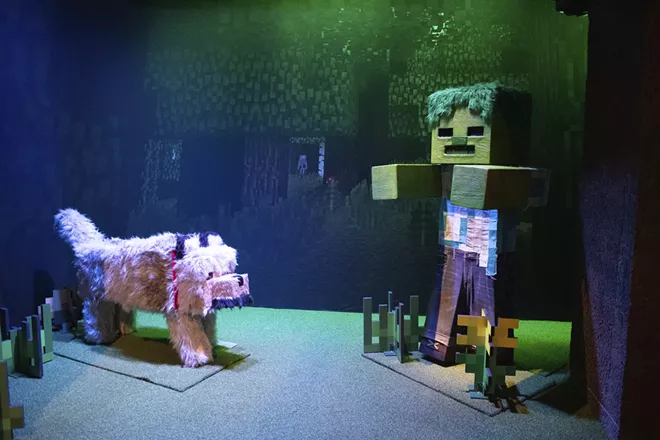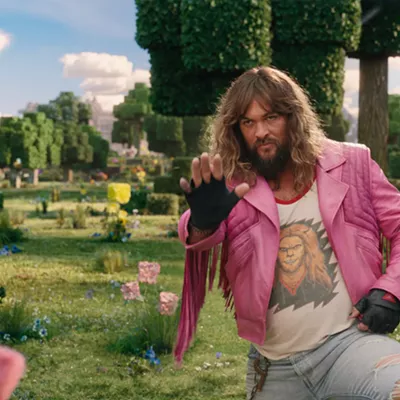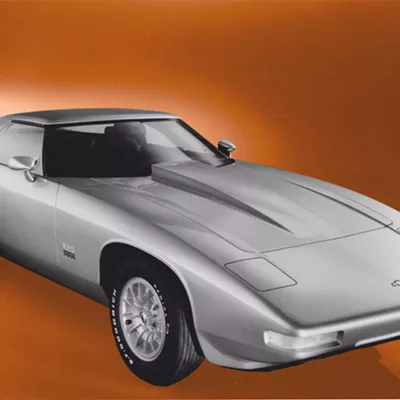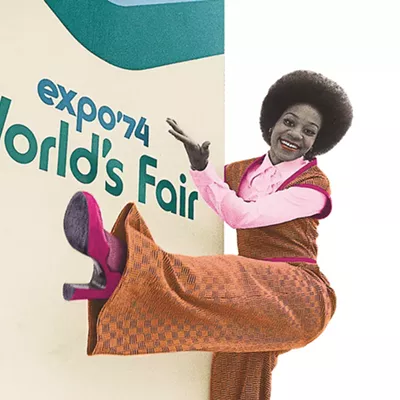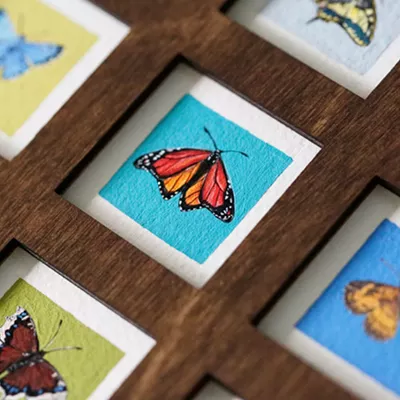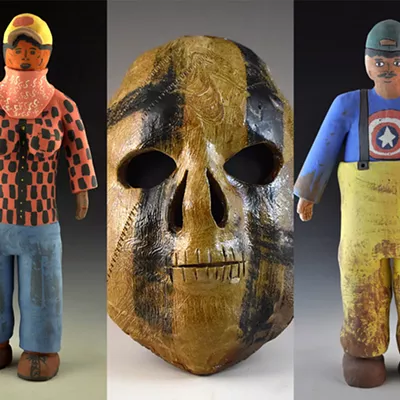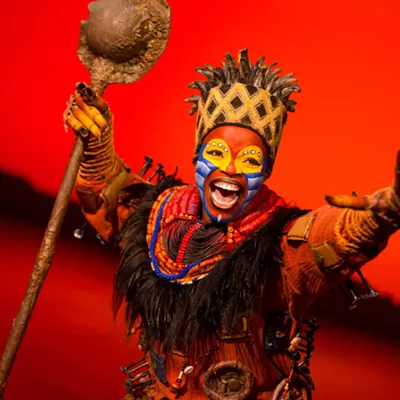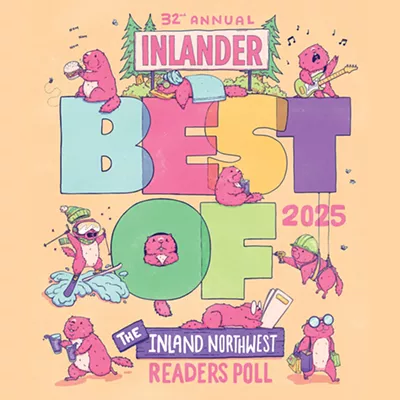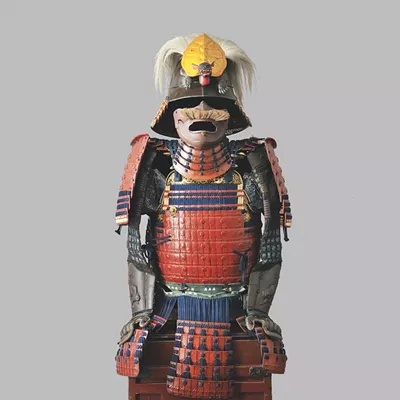In Minecraft, creativity is limitless... as long as you're using chunky, six-sided blocks.
Which brings up a good question: What would it be like to go inside Minecraft's mega-pixelated, geometric world? Fans of the best-selling video game of all time can teleport themselves inside — sort of like walking through a Nether portal — while spending a few hours exploring the Northwest Museum of Arts & Culture's latest marquee exhibit, on display through the end of the year.
At the entrance to "Minecraft: The Exhibition," they'll be greeted by player character Alex, who's all suited up in her teal diamond armor with an arrow nocked in her bow, ready to explore a new biome or dig deep underground for treasure (don't forget plenty of torches!). Outside the front door of a wood-and-cobblestone house shaded by the leafy canopy of a stout tree stands a fluffy llama with a purple patchwork blanket draped over its back. Listen carefully, and you might even hear its goofy bleats or a spitting sound.
"That's one of the cool things about this show, is that it's built to scale as though you're walking through Minecraft yourself," says Kayla Tackett, director of the MAC's exhibitions and collections.
"There's a fun thing here," she continues, pointing to another feature. "How big is a Minecraft block, really? This is actually the scale of a Minecraft block, so you can see how enormous they are."
The block she's talking about — which an avatar in the game can effortlessly pick up in one hand and carry by the dozens in their inventory — is about waist high and looks very heavy.
Like this, along with Alex and her llama friend, the show is filled with game elements scaled up to human size. The best part? Visitors can pose for photos with and even touch all of them! (Of course, as tempting as it may be, climbing is strictly prohibited.)
Tackett says the exhibit features 15 of these full-scale "mobs," the Minecraft term for non-playable characters, also known as NPCs in gamer parlance. But, watch out! A few aren't known to be very friendly, including a creeper, a skeleton archer, a zombie, a zombie piglin and even a glowing-eyed enderman.
"It's very interactive and full of fun little surprises," Tackett says, adding that museum guests who can find all 15 characters will know they've explored every corner of the exhibit.
In one such area, visitors can test how well they know common Minecraft recipes with a life-size crafting table and a furnace, the latter used to turn raw ore found in the game's cavernous mines into usable materials. Alex's super-strong diamond chestplate, for example, can be made by placing eight rare diamonds onto a crafting table in a preset arrangement, known as a crafting recipe.
"There are a lot of things where you can play Minecraft on a controller or with a mouse and keyboard, but there are analog things you can do, too," Tackett says.
"Minecraft: The Exhibition" is on loan from Seattle's Museum of Pop Culture (MoPOP). It was created in collaboration with the game's developer, Mojang Studios (which Microsoft acquired in 2014) to celebrate Minecraft's 10th anniversary in 2019. After leaving MoPOP in 2021, the exhibit went on tour to a few other U.S. museums. Its last stop before retiring is Spokane.
MINECRAFT:
THE EXHIBITION
Sept. 16-Dec. 31
Open Tue-Sun from 10 am-5 pm (third Thursdays until 8 pm)
$15-$20 (free for members)
Northwest Museum of Arts & Culture 2316 W. First Ave. northwestmuseum.org, 509-456-3931
More than galleries filled with adorable and highly detailed characters and objects from Minecraft, the exhibition thoroughly explores the game's massive global impact, both as entertainment and a learning tool. To date, the game has sold more than 238 million copies, and has over 140 million monthly, active players.
Standing in front of a large display imagining a Minecraft-obsessed kid's bedroom — dozens of stuffed animals, Legos and other licensed toys spill from a bookshelf — Tackett recalls her own memories playing the game with her now-12-year-old daughter, Elodie, and how often it's used in schools as a teaching tool.
"We usually just play in creative mode and make things like statues of SpongeBob and Patrick, and we made a movie theater, an aquarium, a zoo, a ship and just whatever — anything we can come up with," she says.
The myriad ways Minecraft can be used for good are highlighted in a section called "Building a Better World." From initiatives on clean water, preserving coral reefs and making streets safer for girls to walk to school in Hanoi, Vietnam, Minecraft has played a role.
"Schools are using Minecraft to help teach kids about everything — engineering and history," Tackett says. "Essentially it's blocks, and you can do anything with blocks."
By the time visitors have made it to this point in the exhibit, it's highly likely they're feeling eager and inspired to log on themselves and get to building, exploring and having fun. With this in mind, the next space is filled with gaming stations on iPads, PCs, and an Xbox set up for multiplayer mode.
"So you can play in a familiar way or you can try something you haven't tried," Tackett says. "It'll be different environments that you can play in, like over here on the iPads, it's mini games and mods, and this one is survival mode."
A Minecraft mod, short for modification (and not to be confused with a Minecraft mob), is a user-created customization that alters the game, ranging from simple, cosmetic changes like surface textures to complex additions of new characters and items. Mods continue to contribute to the game's massive success and appeal, and serve as a way for players of all ages to explore computer coding.
Through the end of the year, special programs tied to the show are also being offered. Visitors can find more info as these events are announced on the MAC's website. On Dec. 9, Whitworth professor and game-based learning expert Tammie Schrader is giving a lecture titled "Games and Their Impact on Education."
While the MAC's regular exhibition slate often explores visual arts and history, shows like "Minecraft: The Exhibition" are an important part of its mission to engage guests through both learning and entertainment.
"It's a really interesting show in the sense of, you know, it's not a capital 'A' art show, but it does speak to things that a lot of people can relate to, like building with blocks and designing," Tackett says. "I think it can be easy to say 'Oh, Minecraft is just a game, why are you doing a show about a game?' But the exhibition shows us pretty well that it's really more than a game — it's an avenue for creativity and problem-solving."
What's also special about the exhibit, she notes, is that it's one of few opportunities at a traditional museum for kids to guide their family members.
"This will be a chance for kids to be the experts. We actually had one staff member say their kiddo was like, 'If you need me to come explain what things are, I will come do that.'" ♦

